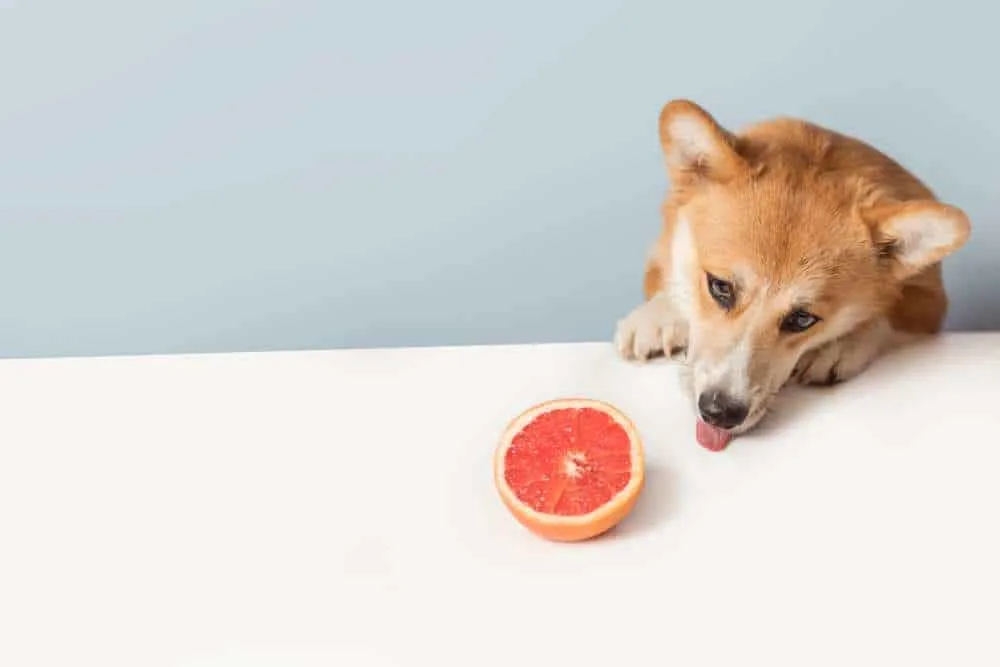A bowl full of fruits is standing on your kitchen counter and you could really use a healthy refreshment. Just as you take a bite of that yummy orange, your pup appears next to you. Although you are almost done with your snack, you ask yourself – can I feed my pup orange peels?
Dogs have been known to chew on all kinds of fruits and vegetables like cucumbers; they’ll even try applesauce if you let them. Your pet might take every opportunity to snack on something but not every meal is ideal for your pup.
If you are having second thoughts about feeding your dog orange peels and are interested in finding out more about this citrus fruit, stay tuned!

Can Dogs Eat Orange Peels?
Sometimes, what is healthy for humans might not necessarily be healthy for dogs. In this particular case, keep your dog away from orange peels at all costs!
Orange peels can be harmful to dogs because they will have a hard time digesting them and this often leads to dog diarrhea and vomiting. This fruit is the source of stomach problems and it can be a very painful experience for any pet, especially for dogs. Choking problems are also a very common outcome of letting your dog eat orange peels.
If you want to keep your pup safe from stomach and choking problems, be sure to keep orange peels away from your dog and throw them in the trash can immediately after eating. However, if your dog happens to show some symptoms, take him to the vet.

How Healthy Are Oranges?
Oranges come from the genus Citrus and they are a part of citrus trees like lemons, grapefruits, limes, etc. Oranges were established in Florida between 1513 and 1565 with the seeds originally imported from Europe. There are many different types like mandarine, Cara Cara, blood oranges, etc. In the past, California was known as the number one producer of oranges for fresh consumption (90,6%).
Oranges range in size between 2-4 inches and the surface can be either smooth or rough with pockmarks. The thickness of the peel depends on the growth of the orange.
Oranges are known for their sweetness and vitamin C. They also contain certain antioxidants that can prevent inflammation. Since oranges don’t contain sodium, they are excellent for lowering blood pressure. One cup of orange juice contributes to a person’s daily potassium intake of 14%. Consuming oranges regularly can seriously help in reducing the risk of type 2 diabetes. Oranges produce collagen which heals wounds and improves skin strength.
Here is what one medium orange contains:
- 61.6 calories
- 0.16g of fat
- 237 milligrams of potassium
- 15.4g of carbohydrate
- 12.2g of sugar
- 1.23g of protein
The United States Department of Agriculture states that one medium orange is a source of essential vitamins for a person’s daily intake. Let’s look at the following guidelines of the nutrients and their percentage required for both men and women.
| Nutrients | Percentage |
|---|---|
| Vitamin C | 92.93% (women), 77.44% (men) |
| Thiamin | 10.36% |
| Folate | 9.83% |
| Fiber | 9.43% |
| Calcium | 4.36-5.24% |
| Potassium | 5.04% |
Although oranges have proven to be a healthy nutrient, they can also have some negative effects on human health.
From 1989 to 2014, there have been around 800 diseases concerning oranges. These outbreaks were linked to Salmonella and in 1995, the unpasteurized orange juice caused 72 illnesses in 21 states. Since this outbreak was caused by contamination in the production process, it was decided that only pasteurized orange juice would be sold. Further investigation revealed that this venture was not a success and discovered 207 new cases across 15 states.

Orange Poisoning With Dogs
Eating one or two orange peels won’t necessarily be fatal to your dog but if he consumes a larger amount all at once, it could lead to orange poisoning. Although owners tend to feed their pups slices of oranges, this is not recommended by the vet.
Some of the most common symptoms of orange poisoning are:
- Drooling
- Weakness
- Vomiting
- Diarrhea
- Choking
- Depression
- Muscle spasms
- Photosensitivity
- Intestinal obstruction
In order to recognize orange poisoning early, the vet must be given as much information as possible (when, where, and how many orange peels were consumed). After that, the dog will be thoroughly examined (oxygen level, weight, skin condition). If your pup happens to be experiencing some type of cardiac pain, an EKG will probably be necessary.
The toxic compound in oranges might not be deadly to your dog, but it is still a serious problem. Some of the most common dangers are:
- Citric Acid – causing shortness of breath and cough
- Synephrine – causing stroke and respiratory distress
- Volatile oils – causing skin and eye irritation
Treating this type of illness includes following these stages:
| Elimination | Giving the dog an emetic. |
| Detoxification | Rinsing away any undigested plant particles. |
| Medication | Giving the dog antiemetics. |
| Observation | Observing your dog at home. |
Do not fear much for your dog because it will most likely recover in a couple of days. You just need to provide him with a sufficient amount of water and healthy foods daily.
Why Citrus Plants Are Toxic to Dogs?
Having citrus plants in your garden might not be an ideal environment for your dog since they should not be given this type of fruit. It is very important that owners understand the danger that this plant can cause.
Citrus poisoning in dogs is caused by the combination of compounds and this is characterized by:
- Weakness,
- Cold limbs,
- Collapse,
- Tremor,
- Excessive drooling, etc.
Ingredients that are responsible for citrus poisoning are limonene, linalool, and psoralen. Limonene is the primary component and can be used in cleaning products. Linalool is known for its floral smell and therefore it is used in lotions and soaps. Psoralen is found in almost every citrus plant and is used for the treatment of skin disorders.

How To Prevent My Dog From Eating Orange Peels?
Since orange peels shouldn’t be a snack for your dog, you should pay attention that you get rid of them before your dog has a chance to try them.
Preventing your dog from eating this fruit doesn’t mean that you should stop buying or consuming it. One way to keep your dog safe is to put your oranges in a plastic bag, close it, and put it someplace your dog can’t reach them. When you finish peeling oranges, you should throw the leftovers right away. Try not to bring unpeeled oranges into any part of the house so as not to drop the pieces on the floor for your dog to pick them up.
The best and most useful thing you can do so that your dog would not be tempted to bite the peel of the orange is to try to teach him through training at an early age what he is allowed and what he is not allowed to eat.

Conclusion
By scrolling through this article, you learned why orange peels are not a healthy snack for your dog as well as a couple of other useful information about this tasty fruit.
Dogs should not be allowed to eat orange peels because they are a source of dangerous problems like diarrhea and vomiting. If you notice these symptoms with your dog, a vet should be consulted right away.
Oranges are citrus fruit with many health benefits like lowering blood pressure, the production of collagen, and preventing stage 2 diabetes. However, in the past, there have been outbreaks of orange poisoning which have spread across more than 20 countries.
Orange poisoning is common with dogs and some of the most visible symptoms are drooling, weakness, vomiting, choking, etc. If these signs are recognized at an early stage, the dog is then redirected to the vet who initiates a treatment procedure.
Citrus plants are bad for dogs because they contain some toxic ingredients such as limonene, linalool, and psoralen which are used in lotions and cleansing products.
To prevent your dog from eating orange peels, you don’t need to stop buying them. You should put them in a plastic bag far away from your dog’s reach, throw the peels immediately after peeling or teach the dog during the early years through training that he is not allowed to eat orange peels.
Learn More: What Can Dogs Eat? A Comprehensive List Of Dog-safe Foods


